|
All That
Gleams
by
Bob Brooke
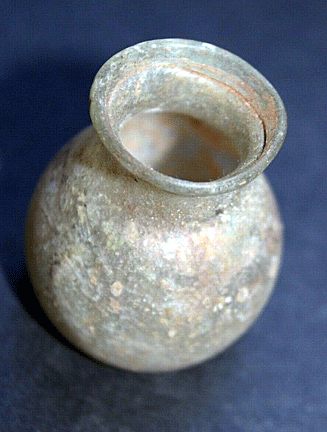 The
Romans used more glass than any other ancient civilization. In 63 BCE,
they conquered the peoples of the Eastern Mediterranean and returned to
Rome with skilled glass makers, making Roman glass over 2,000 years old. The
Romans used more glass than any other ancient civilization. In 63 BCE,
they conquered the peoples of the Eastern Mediterranean and returned to
Rome with skilled glass makers, making Roman glass over 2,000 years old.
The Romans used glass in nearly every part of their daily lives. Small
boxes and bottles held toiletries, cosmetics, oils, medicines, herbs,
and perfumes. Merchants and traders packed, shipped, and sold food
products and other goods across the Mediterranean in glass bottles and
jars of all shapes and sizes. Later, colorful sparkling glass bowls and
beakers holding wine, fruit, and herb-infused olive oils graced dinner
tables.
The Romans used glass primarily for the production of vessels. Using the
glass making techniques of the Hellenic Greeks, they originally
concentrated on the production of intensely colored cast glass vessels.
However, during the 1st century CE, colorless or “aqua”' glasses became
dominant.
Despite the growth of glass working and the growing place of glass in
Roman life, there was still no Latin word for it in the 1st century CE.
Glass Making
Most Roman glass making techniques were time-consuming, and the initial
product was a thick-walled vessel which required considerable finishing.
This, combined with the cost of importing natron for the production of
raw glass, contributed to the limited use of glass and its position as
an expensive and high-status material.
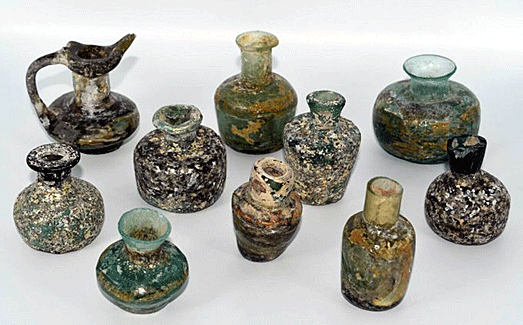
Glassmakers produced glass by core forming, casting, cutting and
grinding. But it was an expensive process, so only the wealthy could
afford it. With the invention of glass blowing around 50 BCE, glass
instantly became available to everyone. The Roman glass industry rapidly
developed over a couple of generations during the first half of the 1st
century CE. Glass vessels became commonplace throughout the empire. And
the Romans even exported them to Scandinavia and the Far East.
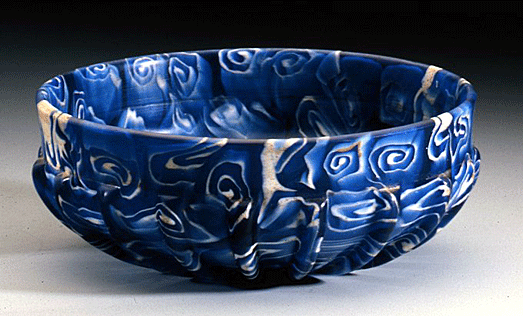
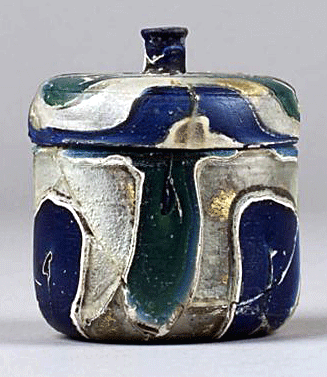 Roman
glassmakers used sand, alkali, sodium carbonate, and metal coloring
agents to produce raw glass. Eventually, it became a high art, producing
items in a large range of colors, patterns and complex techniques. They
used copper to make turquoise to light blue, green, or red colored
glass. Adding cobalt created dark blue glass. Glassmakers used manganese
and antimony to make the glass yellow, white, and purple. Iron made a
light blue, green, brown and black. Glassmakers chose a wide assortment
of colors to simulate the colors of gemstones, such as lapis, amethyst,
and turquoise. Roman
glassmakers used sand, alkali, sodium carbonate, and metal coloring
agents to produce raw glass. Eventually, it became a high art, producing
items in a large range of colors, patterns and complex techniques. They
used copper to make turquoise to light blue, green, or red colored
glass. Adding cobalt created dark blue glass. Glassmakers used manganese
and antimony to make the glass yellow, white, and purple. Iron made a
light blue, green, brown and black. Glassmakers chose a wide assortment
of colors to simulate the colors of gemstones, such as lapis, amethyst,
and turquoise.
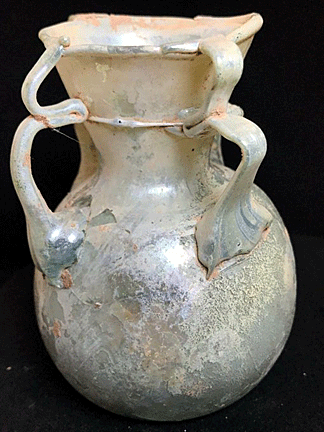 Roman
glass production relied on the application of heat to fuse two primary
ingredients—silica and soda. Glass workshops could produce tons of raw
glass in a single furnace firing, and although this firing might have
taken weeks, a single primary workshop could potentially supply multiple
secondary glass working sites. Historians believe that raw glass
production centered around a relatively small number of workshops, where
the Romans produced glass on a large scale, then broke it into chunks. Roman
glass production relied on the application of heat to fuse two primary
ingredients—silica and soda. Glass workshops could produce tons of raw
glass in a single furnace firing, and although this firing might have
taken weeks, a single primary workshop could potentially supply multiple
secondary glass working sites. Historians believe that raw glass
production centered around a relatively small number of workshops, where
the Romans produced glass on a large scale, then broke it into chunks.
Glassmaking required fuel in large quantities, sources of sand which
represented the major component of the glass, as well as natron to act
as a flux. Since natron could be found only in the region of the Eastern
Mediterranean, the Romans traded raw colorless or naturally colored
glass which they produced for it.
Archaeologists believe that melting didn’t take place in crucibles but
rather in cooking pots used for small scale glass operations. For larger
amounts of glass, the Romans built large tanks or tank-like ceramic
containers and in the largest cases, built large furnaces to surround
these tanks.
Glass Working
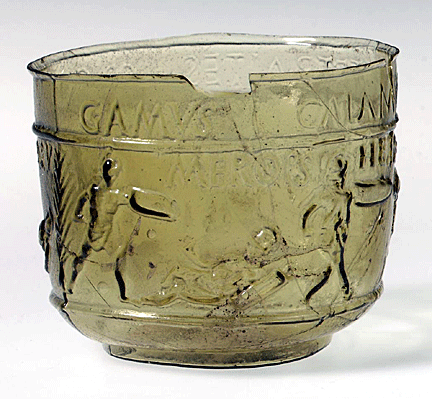 The
Romans separated glass making from glass working. Unlike the making
process, the working of glass required significantly lower temperatures
and substantially less fuel. As a result of this and the expansion of
the Empire, glass working sites developed in Rome, Campania and the Po
Valley by the end of the 1st century CE, producing the new blown vessels
alongside cast vessels. The
Romans separated glass making from glass working. Unlike the making
process, the working of glass required significantly lower temperatures
and substantially less fuel. As a result of this and the expansion of
the Empire, glass working sites developed in Rome, Campania and the Po
Valley by the end of the 1st century CE, producing the new blown vessels
alongside cast vessels.
By the early-to-mid-1st century CE, the growth of the Empire saw the
establishment of glass working sites at locations along trade routes,
with Cologne and other Rhineland centers becoming important glass
working sites from the Imperial period, and Syrian glass being exported
as far as Italy. During this period vessel forms varied between
workshops, with those in the Rhineland and northern France producing
distinctive forms which aren’t seen further south.
 Glassblowing
allowed glass workers to produce vessels with considerably thinner
walls, decreasing the amount of glass needed for each vessel. Glass
blowing was also considerably quicker than other techniques, and vessels
required considerably less finishing, representing a further saving in
time, raw material and equipment. Although earlier techniques dominated
during the early Augustan and Julio-Claudian periods, by the middle to
late 1st century CE, earlier techniques had been largely abandoned in
favor of blowing. Glassblowing
allowed glass workers to produce vessels with considerably thinner
walls, decreasing the amount of glass needed for each vessel. Glass
blowing was also considerably quicker than other techniques, and vessels
required considerably less finishing, representing a further saving in
time, raw material and equipment. Although earlier techniques dominated
during the early Augustan and Julio-Claudian periods, by the middle to
late 1st century CE, earlier techniques had been largely abandoned in
favor of blowing.
Glass vessel production reached its peak at the beginning of the 2nd
century CE, with glass objects common throughout the Roman Empire. The
primary production techniques of blowing, and to a lesser extent
casting, remained in use for the rest of the Roman period, with changes
in vessel types but little change in technology. From the 2nd century
onwards styles became increasingly regionalized, and archaeological
evidence suggests that bottles and closed vessels such as unguentaria,
or vessels used to hold olive oil, moved throughout the empire as a
by-product of the trade in their contents, and many appear to have
matched the Roman scale of liquid measurement. The use of colored glass
as a decorative addition to pale and colorless glasses also increased,
and metal vessels continued to influence the shape of glass ones.
Decorative Glass Techniques
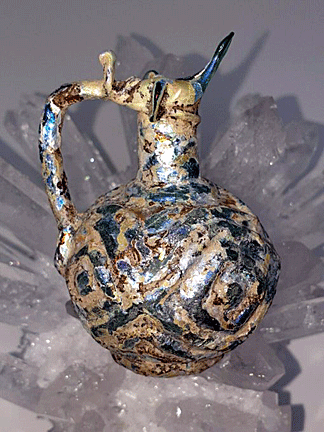 The
Romans produced several patterns of glass. Floral, known today as
millefiori, and spiral patterns: Glassmakers produced these by
binding rods of colored glass together and heating and fusing them into
a single piece. They then cut them in cross-section, and the resulting
discs could be fused together to create complex patterns. Alternately,
two strips of contrasting-colored glass could be fused together, and
then wound round a glass rod whilst still hot to produce a spiral
pattern. Cross-sections of this were also cut, and could be fused
together to form a plate or fused to plain glass. The
Romans produced several patterns of glass. Floral, known today as
millefiori, and spiral patterns: Glassmakers produced these by
binding rods of colored glass together and heating and fusing them into
a single piece. They then cut them in cross-section, and the resulting
discs could be fused together to create complex patterns. Alternately,
two strips of contrasting-colored glass could be fused together, and
then wound round a glass rod whilst still hot to produce a spiral
pattern. Cross-sections of this were also cut, and could be fused
together to form a plate or fused to plain glass.
Glassmakers created marbled and dappled patterns by distorting the
original pattern during the slumping of the glass plate during melting.
However, by using spiral and circular patterns of alternating colors
producers could imitate the appearance of natural stones such as
sardonyx.
To produce lace patterns, glassmakers twisted strips of colored glass
with a contrasting colored thread of glass before being fused together.
Though this was a popular method in the early period, it appears to have
gone out of favor by the mid-1st century CE.
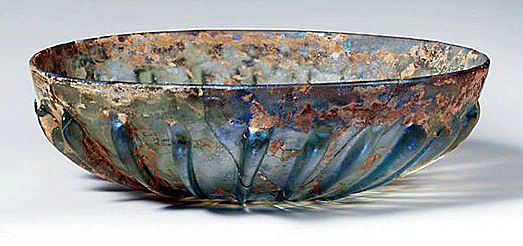
By fusing lengths of monochrome and lacework glass together, glassmakers
could create vivid striped designs, a technique that developed from the
lace pattern technique during the last decades of the 1st century CE.
The Romans also produced enameled glass and engraved glass.
<
Back to Antiques Archives
Next Article > |
